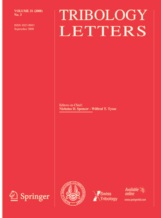Doing it right
Drs. Wilfred T. Tysoe & Nicholas D. Spencer | TLT Cutting Edge April 2009
A new section of Tribology Letters improves our ability to generate accurate measurements and share information.

Editing a top tribology journal is fun but does have its downsides. Now and then we receive papers describing measurements that were simply not carried out properly and are dominated by artifacts.
One problem is that much of the know-how involved in tribological measurements is passed from generation to generation of graduate students rather than being readily available in books. Consequently, newly established laboratories or new students have a tendency to reinvent the wheel for a while before establishing their own way of making measurements reliably.
Standardized test procedures such as those published by ASTM are invaluable, of course, but do not cover all types of tribological measurements. For this reason, we have decided to start a new section of
Tribology Letters titled Tribology Methods. This section will include peer-reviewed papers that describe the best way to make particular tribological measurements and introduce new techniques that might be generally useful to the tribological community.
Arguably one of the most misused weapons in the tribological arsenal is the atomic force microscope (AFM). Scott Perry of the University of Florida has, with his colleagues, devoted one of our first Tribology Methods papers to this topic. The AFM, which was developed in the 1980s, brought nanometer-scale imaging and later nanoNewton-scale friction measurement within the reach of virtually all tribology laboratories.
AFM has the potential to model the friction of a single asperity with a counter-surface, generate information on real contact areas and provide mechanistic insights into friction on the molecular level. Unfortunately, the literature abounds with contradictory tribological data obtained by AFM, and reliable comparisons between laboratories have been difficult at best. As a result, AFM friction data have yet to be routinely applied for design purposes.
One particular problem is the calibration of the lateral force constant of the AFM spring cantilever (the force-measuring heart of the instrument), although a number of techniques have been described in the literature for doing this and are comprehensively referenced by Perry. A less well-documented issue is the misalignment of the laser beam (used for detecting the cantilever motion), which also leads to uncertainties in the measured friction values. Perry and his colleagues deliberately misaligned a laser beam in their AFM to show how this can have dramatic effects on friction measurements.
One of the most useful sections of the paper is the detailed description of how to carry out friction-load measurements with an AFM. Instead of recording friction at a number of discrete load values, an approach that is frequently reported in the literature, Perry and his coworkers suggest that
continuously varying the load while scanning along a line on a sample generates a useful
friction-load map. This can provide information on adhesion phenomena, hysteresis effects between loading and unloading cycles and non-linearities in the friction-load curve—yielding insights into the contact mechanics. Additionally, some information can be gained into the onset of wear.
We hope that our new Tribology Methods section will contribute to a higher quality of data in the literature and lead to results that can be more readily compared between laboratories. The first issue of
Tribology Letters to contain such papers will appear shortly.
FOR FURTHER READING:
Limpoco, F.T., Payne, J.M. and Perry, S. (2009), “Experimental Considerations When Characterizing Materials Friction with Atomic Force Microscopy,”
Tribology Letters, (Currently in production).
Cannara, R.J., Eglin, M. and Carpick, R.M. (2006), “Lateral Force Calibration in Atomic Force Microscopy,”
Rev. Sci. Instr., 77, 053701/1-11.
 Eddy Tysoe is a Distinguished Professor of Physical Chemistry at the University of Wisconsin-Milwaukee. You can reach him at wtt@uwm.edu
Eddy Tysoe is a Distinguished Professor of Physical Chemistry at the University of Wisconsin-Milwaukee. You can reach him at wtt@uwm.edu.
 Nic Spencer is professor of surface science and technology at the ETH Zurich, Switzerland. Both serve as editors-in-chief of STLE-affiliated Tribology Letters journal. You can reach him at nspencer@ethz.ch
Nic Spencer is professor of surface science and technology at the ETH Zurich, Switzerland. Both serve as editors-in-chief of STLE-affiliated Tribology Letters journal. You can reach him at nspencer@ethz.ch.